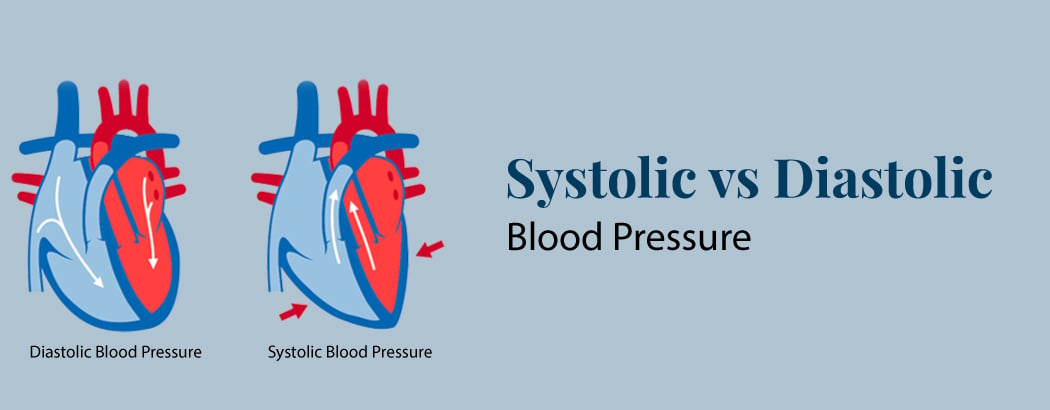Demystifying Blood Pressure: Exploring Systolic vs. Diastolic Measurements
March 25, 2024

Blood Pressure
Your heart’s workload is gauged by your blood pressure. The first number on your reading is your systolic blood pressure; the second is your diastolic blood pressure.Systolic and diastolic blood pressure are two fundamental components that are used to assess heart health.
Contents
Systolic Blood Pressure
The force applied to artery walls during each heartbeat is reflected in the systolic blood pressure. The systolic phase is represented by the contraction of your heart as it pumps blood throughout your body.
A healthy systolic pressure is usually less than 120 mm Hg,measured in millimetres of mercury (mmHg) and it is shown by the top number in a blood pressure reading. This measurement is important because it assesses how well the heart pumps blood. High systolic pressure might cause arterial strain and consequent cardiovascular problems.
A good systolic blood pressure that is less than 120 mm Hg is essential for heart health generally because it means the heart is pumping blood effectively to meet the body’s needs.
Diastolic Blood Pressure
The second figure in a blood pressure reading, the diastolic blood pressure, represents the pressure in the arteries between heartbeats. A normal diastolic pressure is usually less than 80 mm Hg, measured in millimetres of mercury (mmHg). This stage, which shows how well blood vessels contract and relax after each heartbeat, is vital.
The diastolic pressure is 80 in a reading such as 120/80 mmHg. The heart’s ability to rest may be impacted by persistently high diastolic pressure, which could indicate health issues and result in difficulties.
Distinctions between Systolic and Diastolic Blood Pressure
The primary distinctions between systolic and diastolic blood pressure are as follows:
1.Explanation:
- Systolic blood pressure (SBP) is the force that is generated as the heart beats, forcing blood into the arteries.
- When the heart relaxes in between beats, the force is known as diastolic blood pressure, or DBP.
2.Measurements:
- In blood pressure readings, systolic blood pressure is the greater number.For example, if the measurement is 120/80 mm Hg, the SBP is 120 .
- In blood pressure readings, diastolic blood pressure is the lower number. For example, if the measurement is 120/80 mm Hg, the DBP is 80.
3.Working of the Heart:
- The heart’s pumping effort is reflected in systolic blood pressure.
- The heart’s rest phase is shown by diastolic blood pressure .
4.Arterial Pressure:
- Systolic blood pressure measures pressure in arteries during a heartbeat.
- Diastolic blood pressure measures pressure during a heartbeat.
5.Relevance:
- Elevated systolic blood pressure could suggest blockages or stiffness in the arteries.
- Elevated diastolic blood pressure might suggest problems with arterial relaxation or constriction.
6.Risks:
- Elevated systolic blood pressure is associated with heart strain, stroke, and renal difficulties.
- Elevated diastolic blood pressure is associated with kidney problems and increased risk of heart disease.
7.Effect of Age:
- Systolic blood pressure often rises with age.
- Diastolic blood pressure may drop after the age of 50.
8.Exercise Effect:
- Exercise on a regular basis can affect systolic blood pressure more than diastolic blood pressure.
9.Medication:
- For efficient blood pressure management, antihypertensive drugs frequently target both systolic blood pressure and diastolic blood pressure.
10.Range of blood pressure:
- A healthy blood pressure reading is between 120 and 80 mm Hg, however this might change depending on age and other factors.
Effects of fluctuations in Blood Pressure
Regardless of age, systolic blood pressure is the most reliable indicator of future cardiovascular events and death. At any age, arterial pressure is a reliable indicator of cardiovascular risk and mortality. Both the diastolic and systolic blood pressures need to be monitored by patients and medical professionals.
A systolic blood pressure of 130 mmHg or higher, or a diastolic blood pressure of 80 mmHg or higher, is considered high blood pressure.Because it silently destroys blood vessels and can cause major health problems, high blood pressure is frequently referred to as the “silent killer”.
Maintaining Healthy Pressure Range
It is advisable to maintain a normal pressure i.e. 120/80 mm Hg, which is considered healthy. Following are some ways in which an individual can work towards maintaining a healthy pressure:
- eating a well-balanced diet low in salt
- moderate alcohol use
- abstaining from tobacco
- frequent physical activity
- stress management
- keeping a healthy weight
Conclusion
Measured both during the heartbeat (diastolic) and in between beats (systolic), blood pressure represents the force within your arteries. The diagnosis and treatment of high blood pressure depend on both of these levels.
Treatment for a variety of ailments, such as heart disease or significant blood loss, may also benefit from knowledge of the diastolic and systolic blood pressure. Systolic and diastolic blood pressure measurements must be taken on a regular basis in addition to adopting a healthy lifestyle to maintain balanced blood pressure and overall cardiovascular health. Patients can take control of their health and learn vital information about blood pressure patterns from routine exams.
Frequently Asked Questions
1. Which number matters most when I’m checking my blood pressure? The systolic, the diastolic, or both?
Physicians mainly focus on the top number in a blood pressure reading, also called the systolic pressure, even though both numbers are crucial for identifying and treating high blood pressure.
2. Why do diastolic and systolic measurements matter?
The measurements of the diastolic and systolic blood pressure are important markers of cardiovascular health. Diastolic pressure measurement occurs when the heart is at rest, whereas systolic pressure measurement occurs when the heart contracts. Keeping an eye on these numbers aids in determining the risk of heart disease, directing healthcare decisions and preventative actions.
3. Why is it vital to monitor both?
Tracking changes requires constant observation. You may obtain a thorough picture of any scenario and identify any cardiac problems early on by keeping an eye on both.
4. What is the indication of a high diastolic blood pressure?
When the heart is at rest in between beats, there is increased pressure in the arteries, as indicated by a high diastolic blood pressure reading (the bottom number, usually above 90 mm Hg). Possible risks for heart disease, stroke, or other cardiovascular problems may be indicated by this.







